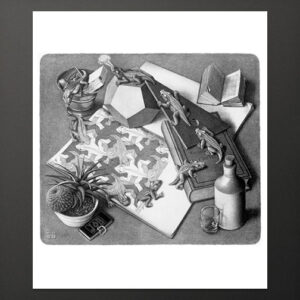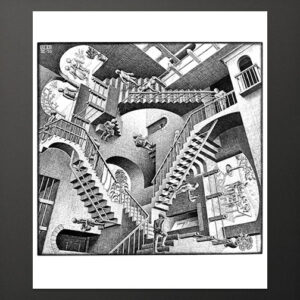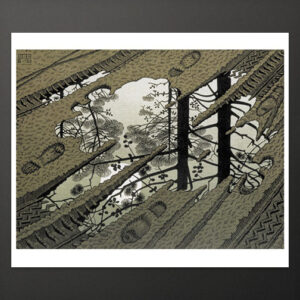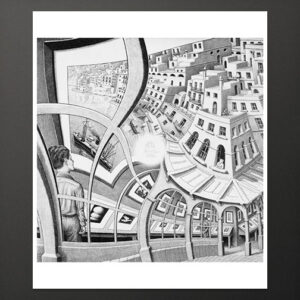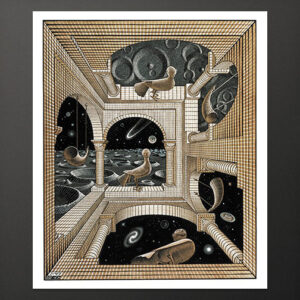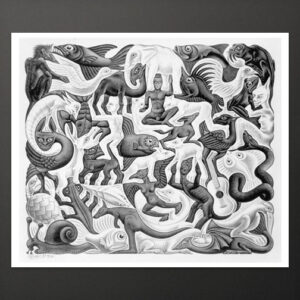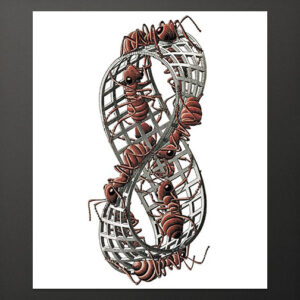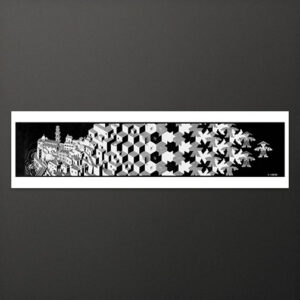-
M.C. Escher’s Reptiles (1943) is a whimsical yet thought-provoking lithograph that blurs the line between two-dimensional and three-dimensional space. In this print, a series of small, tessellated reptilian figures emerge from the flat surface of a drawing, come to life, and crawl across a cluttered tabletop, only to return to their original, flat form. This cyclical movement creates a fascinating interplay between art and reality, showcasing Escher’s signature themes of transformation, illusion, and the paradoxical relationship between the flat and the spatial. With its meticulous detail and playful narrative, Reptiles invites viewers to question perception and the nature of artistic creation itself. Printed in black and white on poster paper. Packaged in cardboard tube. Paper size : 55 x 65 cm. Image size approx : 43,5 x 38 cm.
-
Relativity, lithograph, 1953. "Three gravitational forces act perpendicular to each other here. Three Earth surfaces intersect each other at right angles and on each of them people live. Two inhabitants of different worlds cannot walk, sit or stand on the same floor, because their notions of what is horizontal and what is vertical are not the same. But they can use the same staircase together. On the top staircase shown here, two people move next to each other in the same direction. Yet one descends and the other climbs up. Contact between them is impossible, because they live in different worlds and therefore cannot know of each other's existence." ~ M.C. Escher, Grafiek en Tekeningen. Printed in black and white on poster paper. Paper size : 55 x 65 cm. Image size approx : 43 x 40,5 cm. Packaged in cardboard tube.
-
Mud puddle, woodcut of 3 blocks, 1952. "The cloudless evening sky is reflected in a mud puddle left in the hollow of a forest road after a rain shower. Traces of two trucks, two bicycles and two pedestrians are imprinted in the marshy ground." ~ M.C. Escher, Grafiek en Tekeningen. Printed in color on 170gram paper. Paper size : 55 x 65 cm. Image size approx : 49 x 36,2 cm. Packaged in cardboard tube.
-
Print Gallery, lithograph, 1956. "[In this print an] enlargement towards the center, a ring-shaped expansion takes place, around the empty center, in the direction of a clock. At the bottom right we enter through a gate an exhibition gallery with prints on tables and on walls. First we pass a visitor with his hands behind his back and then, in the lower left corner, a young man who is already four times as big. His head has already expanded in proportion to his hand. He looks at the last print of a series on the wall and follows the details one by one: the boat, the water and the houses in the background. From there, his gaze continues to slide from left to right along increasingly larger blocks of houses down on the sloping roof that covers the exhibition gallery; that is where our tour began. The boy sees all these things as two-dimensional details of the print he is studying. Looking a little deeper, he sees himself, as part of the picture. " ~ M.C. Escher, Grafiek en Tekeningen. Printed in black and white on poster paper. Paper size : 55 x 65 cm. Image size approx : 47,2 x 46,3 cm. Packaged in cardboard tube.
-
Other World, wood engraving of three blocks, 1947. "The interior of a cube-shaped extension. Openings in the five visible walls offer a view of three different scenes. Through the upper pair one can see the ground, almost vertically downwards; the middle two are at eye level and show the horizon; through the lower pair, one looks steeply up at the stars. Each surface of this structure, which logically unites nadir, horizon and zenith, has a triple function. The rear surface in the center, for example, is a wall in relation to the horizon, a floor in relation to it the upper view and a ceiling with regard to the view of the starry sky." ~ M.C. Escher, Grafiek en Tekeningen. Printed in color on poster paper. Paper size: 55 x 65 cm. Image size approx : 41,5 x 50,5 cm. Packaged in cardboard tube.
-
Plane Filling II, lithograph, 1957. "... They could also only be created after years of training with regular fillings. The recognizability of their components as natural objects plays an even more important role. Enjoyment in the difficult game, without symbolic ulterior motives, was the only real reason for their creation... The rectangularity of the entire surface is the only regularity that is still present here. Of the inner figures, only a few are bordered by four surrounding ones. The immediate environment of the frog consists of two figures; the guitar is bounded by three, the rooster by five, and the ostrich (if it is one) by six. The total number is only apparent after careful counting. " ~ M.C. Escher, Grafiek en Tekeningen. Printed in black and white on poster paper. Paper size : 55 x 65 cm. Image size approx : 55,5 x 47,5 cm. Packaged in cardboard tube.
-
Möbius II, woodcut from 3 blocks, 1963. "A closed, looped ribbon usually has two separate surfaces, one inside and one outside. On this strip, however, nine red ants follow each other and walk both the front and the reverse side. So the ribbon has only one surface." ~ M.C. Escher, Grafiek en Tekeningen. Printed in color on poster paper. Paper size: 55 x 65 cm. Image size approx : 27 x 58 cm. Packaged in cardboard tube.

